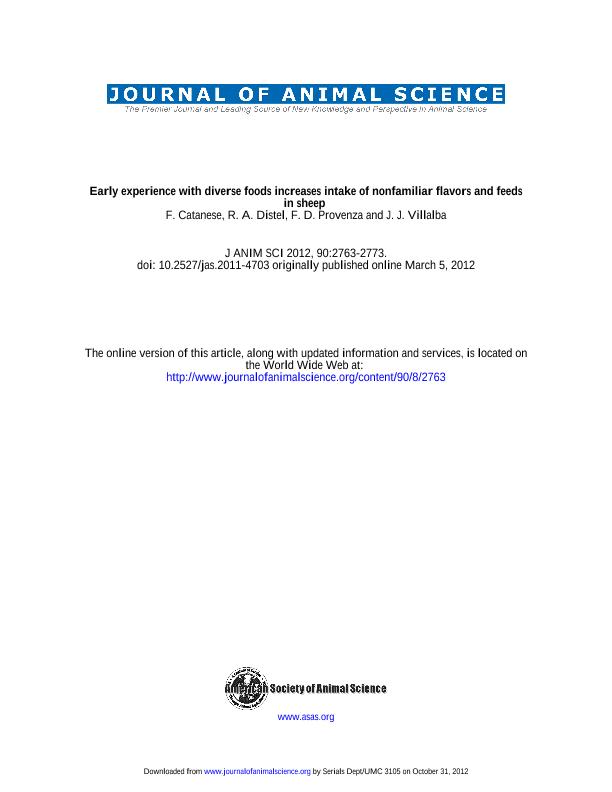Mostrar el registro sencillo del ítem
dc.contributor.author
Catanese, Francisco Hernan

dc.contributor.author
Distel, Roberto Alejandro

dc.contributor.author
Provenza, F.
dc.contributor.author
Villalba, J. J.
dc.date.available
2017-07-07T19:11:00Z
dc.date.issued
2012-08
dc.identifier.citation
Catanese, Francisco Hernan; Distel, Roberto Alejandro; Provenza, F.; Villalba, J. J.; Early experience with diverse foods increases intake of nonfamiliar flavors and feeds in sheep; American Society of Animal Science; Journal of Animal Science; 90; 8; 8-2012; 2763-2773
dc.identifier.issn
0021-8812
dc.identifier.uri
http://hdl.handle.net/11336/19865
dc.description.abstract
This study determined whether early experiences by sheep with monotonous or diverse diets influence intake of unfamiliar flavors and feeds later in life. Thirty 2-mo-old lambs were randomly assigned to 3 treatment diets (n = 10): diverse (DIV), diverse with plant toxins (DIV+T), and monotonous (MON). Lambs in DIV received in 9 successive periods of exposure 4-way choice combinations of 2 foods high in energy and 2 foods high in protein from an array of 6 foods: 3 high in energy [beet pulp, oat grain, and a mix of milo:grape pomace (60:40)] and 3 high in digestible protein (DP) (soybean meal, alfalfa, corn gluten meal). Lambs in DIV+T received the same exposure as DIV, but 2 plant toxins, oxalic acid (1.5%) and quebracho tannins (10%), were randomly added to 2 of the feeds in each of the choice combinations. Lambs in MON received a monotonous balanced diet, made with a mixture of all 6 feeds detailed before. All treatments received their feed in 4 separate buckets. During exposure, treatments did not differ in total daily DMI (P = 0.31), but daily intake of ME was less (P < 0.02) and daily intake of DP was greater (P < 0.03) for lambs in DIV and DIV+T than for lambs in MON. Treatments did not differ in ADG or G:F (P > 0.05). After exposure, lambs were offered a familiar feed (wheat bran) containing novel flavors (maple, garlic, or bitter) and 2-way choices of novel feeds (fescue hay vs. corn distillers grains, rice vs. calf manna, and green peas vs. rolled oats). Intake of maple-flavored wheat bran tended (P = 0.08) to be greater for lambs in DIV than for lambs in DIV+T and MON. Intake of bitter-flavored and garlic-flavored wheat bran were greater (P = 0.03 and P = 0.04, respectively) for lambs in DIV and DIV+T than for lambs in MON. During 2-way choice trials, lambs in DIV, but not in DIV+T, showed greater intakes of fescue hay (P = 0.05) and rice (P = 0.04) than lambs in MON. Intake of green peas was greater (P = 0.03) for lambs in DIV and DIV+T than for lambs in MON. At the end of testing, lambs in DIV but not in DIV+T showed greater ADG than lambs in MON (P = 0.05). Thus, early exposure to diverse foods enhanced acceptance of novel flavors relative to early exposure to a monotonous ration. Early experience with diverse feeds plus plant toxins led to a less diverse diet than early experience with diverse feeds. Early exposure to diverse feeds may be beneficial in production systems that require rapid acceptance and high intake of unfamiliar feeds.
dc.format
application/pdf
dc.language.iso
eng
dc.publisher
American Society of Animal Science
dc.rights
info:eu-repo/semantics/openAccess
dc.rights.uri
https://creativecommons.org/licenses/by-nc-sa/2.5/ar/
dc.subject
Dietary Diversity
dc.subject
Early Food Experience
dc.subject
Neophobia
dc.subject
Sheep
dc.subject
Diet Selection
dc.subject.classification
Ganadería

dc.subject.classification
Producción Animal y Lechería

dc.subject.classification
CIENCIAS AGRÍCOLAS

dc.title
Early experience with diverse foods increases intake of nonfamiliar flavors and feeds in sheep
dc.type
info:eu-repo/semantics/article
dc.type
info:ar-repo/semantics/artículo
dc.type
info:eu-repo/semantics/publishedVersion
dc.date.updated
2017-07-03T14:51:33Z
dc.journal.volume
90
dc.journal.number
8
dc.journal.pagination
2763-2773
dc.journal.pais
Estados Unidos

dc.journal.ciudad
Urbana
dc.description.fil
Fil: Catanese, Francisco Hernan. Consejo Nacional de Investigaciones Científicas y Técnicas. Centro Científico Tecnológico Conicet - Bahía Blanca. Centro de Recursos Naturales Renovables de la Zona Semiarida. Universidad Nacional del Sur. Centro de Recursos Naturales Renovables de la Zona Semiarida; Argentina
dc.description.fil
Fil: Distel, Roberto Alejandro. Consejo Nacional de Investigaciones Científicas y Técnicas. Centro Científico Tecnológico Conicet - Bahía Blanca. Centro de Recursos Naturales Renovables de la Zona Semiarida. Universidad Nacional del Sur. Centro de Recursos Naturales Renovables de la Zona Semiarida; Argentina
dc.description.fil
Fil: Provenza, F.. State University Of Utah; Estados Unidos
dc.description.fil
Fil: Villalba, J. J.. State University Of Utah; Estados Unidos
dc.journal.title
Journal of Animal Science

dc.relation.alternativeid
info:eu-repo/semantics/altIdentifier/url/https://www.animalsciencepublications.org/publications/jas/abstracts/90/8/2763
dc.relation.alternativeid
info:eu-repo/semantics/altIdentifier/doi/http://dx.doi.org/10.2527/jas.2011-4703
Archivos asociados
